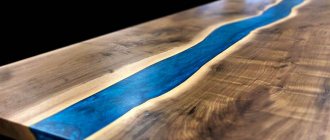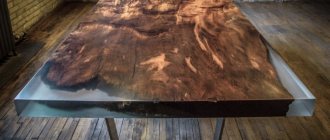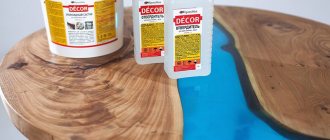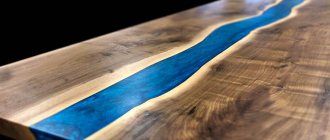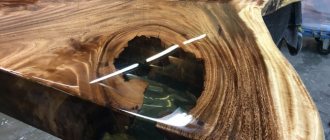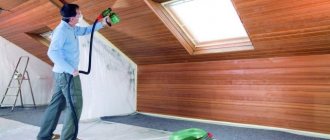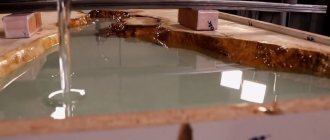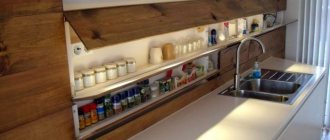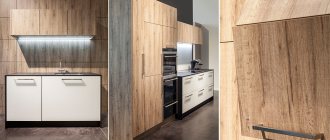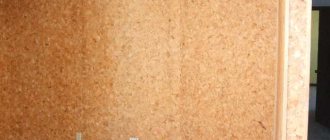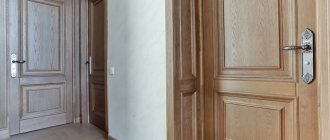Design and construction features
Epoxy resin tables are characterized by a unique design and can fit into any interior. Most often they are used in kitchens and living rooms, and there are no strict requirements for the style solution. Epoxy is used not only to make new products, but also to restore old furniture. Many models are made by combining several materials.
The peculiarity of the resin is that it hardly shrinks after hardening, therefore it retains its original shape for a long time. In addition, it can be decorated in different ways. Resin tables come in several types of designs:
- Combined. In this case, synthetic material alternates with wood elements.
- With the presence of support. Only the top layer is filled with resin. Additionally, various decorative elements are used: leaves, coins, flowers.
- Without the presence of support. There is only epoxy here. Small coffee tables are made this way. They are not intended for significant mechanical loads.
The product can be transparent, single-color or combined. The most commonly used are light turquoise and blue shades. Often the design is equipped with additional lighting or fluorescent powder. Handmade tables have a high cost, but such furniture can be made independently. The advantage of the process is that the cost of the model is reduced. There are other advantages: the opportunity to show imagination, restoring old furniture in an original way.
Combined
With the presence of support
Without the presence of support
Features of the material
Epoxy resin is often used in workshops on making jewelry, crafts, sculptures and interior items. Particularly popular is transparent epoxy, which has enormous scope for imagination. The composition of epoxy for pouring includes synthetic oligomer compounds, alcohols, and a number of other components. To obtain the desired properties, it is necessary to pour a hardener into the product - only after this can the resin harden.
Depending on the amount of hardener and the introduction of other substances, the resin for products can acquire different characteristics. It has the ability to harden or turn into glue, be super strong or rubber-like. To fill dining tables, you need to use solid resins, both for creating new furniture and restoring old ones. It is this coating that will be abrasion resistant and durable.
Advantages and disadvantages of epoxy countertops
A huge advantage of the products is their unique design. The tabletop can have any appearance that the user desires. To decorate chairs, coffee tables, kitchen tables and even desks, different materials are used - pieces of wood and glass, stump cuts, stones, foil and glitter, sawdust and sand. Shells, marble chips, pebbles, souvenirs and money, dried flowers and leaves are also used. The resin can be painted in any color, up to the most saturated tone, to achieve the effect of a landscape, sea, river, etc.
Other advantages of the products are:
- completely waterproof, washable;
- tolerance of many household products;
- no shrinkage during operation, preservation of shape and original color;
- absence of deformation and reaction to moderate mechanical stress.
When choosing this technology, you need to take into account its disadvantages. The cost of a table for the kitchen, living room, countertops for the bathroom will be high. The consumption per 1 m2 of epoxy is high; it can take 10-20 liters of resin or more. If the sequence of actions is violated, at the slightest mistake air bubbles will appear inside, which are difficult to get rid of.
Properties of epoxy resin
Epoxy resin is a synthetic oligomer material. It is not used in its pure form. To obtain a solid fragment, the resin must be polymerized using a hardener. Different proportions of components make it possible to create materials with different physical and mechanical properties. The resin has the following qualities:
- strength and resistance to chemicals;
- no unpleasant odor when working with epoxy;
- the polymerization process occurs at temperatures from -15 to + 80 degrees;
- slight shrinkage after hardening of the material, its stable structure;
- poor moisture permeability;
- high resistance to mechanical damage and abrasive wear;
- no need for expensive care.
When using additional protective components, such a table becomes immune to direct sunlight.
The resin also has some disadvantages: when exposed to high temperatures, it can release harmful substances. To work with the substance, you must have certain skills and fully comply with the application technology. Such material has a high cost.
Durable and chemical resistant
No unpleasant odor when working with epoxy
Minor shrinkage after hardening of the material
Weak moisture permeability
High resistance to mechanical damage and abrasive wear
No need for expensive maintenance
Advantages
In furniture made of epoxy and wood, not only the appearance attracts attention; the positive qualities of the resin are also transmitted to objects made from it, these are:
- Wear resistance. Epoxy resin perfectly tolerates various unfavorable factors: humidity, high temperatures, mechanical stress, etc. Such coatings do not wear out during long-term use.
- Durability. Thanks to this quality, the material significantly increases the service life of furniture.
- Reliability. Resin is very similar to glass, which is often used to create interior items, but it does not break, does not form dangerous chips, and also weighs half as much.
In addition, when epoxy hardens, it is a very plastic material that can be given any shape. It is quite easy to process. The resin adheres well to different surfaces, forming very strong connections. These features of the material attract not only craftsmen, but also amateurs.
Popular modifications
Making a table from epoxy resin is a task for a craftsman with good imagination. In addition to standard pieces of wood, luminescent paints or powders, buttons, wine corks, moss, plant leaves, sea stones, and cobblestones can be used for decoration.
River
A special feature of the river table design with epoxy resin is that it is based on the same placement of elements: an insert made of the specified material is localized between two pieces of wood. It can be straight or follow the curves of the tree, wide or narrow, with decorative fragments, islands, and stones.
The shapes of the tabletops here are different: round, oval, rectangular. Interesting options are in which wood plays the role of a river bank, and resin plays the role of water. These products can be installed in the living room and kitchen. The model looks great in the office. With a river you can make a coffee table in Provence or country style. As for material consumption, about 13-14 kg of substance is needed for a river measuring 210 x 15 x 5 cm.
Solid surface
To create a solid table made of liquid glass, you need to use a mold of the required size. Most often, such structures are made without support and do not provide for intense loads. Tabletops of this type are used for the production of coffee tables or dressing tables. To make an epoxy resin tabletop, the dimensions of which are 100 x 60 x 5 cm, approximately 30 liters of resin are required.
From slab
Slabs are solid massive slabs of wood or stone. To make such a product at home, lighter material is taken. The tree usually represents a longitudinal cut of the trunk with remaining knots and uneven edges. This will allow you to create a unique model.
Often a slab table is made of oak. In this format you can make a kitchen surface, a structure for a living room, or an office. The thickness of the wood material ranges from 5 to 15 cm. It should not be glued or have other joints. To make a table from medium-sized epoxy resin slabs, you will need about 10 kg of the substance.
From cuts
Solid wood tables look very original and rich. Models of saw cuts of wood material coated with an epoxy solution look no less impressive. To fill such a countertop, a minimum of 7 kg of polyester substances is required. This model is perfect for kitchens, cottages in country style, eco-friendly. No matter what kind of hemp or solid trunk the cuts are made from, the design of each of them will be unique.
Tables of this type have different shapes: round, oval, rectangular and even square. The number of fragments used depends on its choice. The material must be of high quality and the required diameter. Cracked elements are not recommended to be used.
DIY table - technology
To make a table, you need to read the instructions and follow all the steps step by step. It is important to remember that epoxy hardens quickly at room temperature, so you should work with it quickly. Some people wonder whether and why it is possible to heat resin with a burner? It is forbidden to heat the fill from above; it will immediately become deformed. Other rules for working with epoxy:
- do not forget about safety measures, use a respirator, gloves, goggles, so as not to harm your health;
- work only in a well-ventilated area;
- Avoid exposure to sunlight until the resin hardens; it may turn yellow;
- do not make sweeping movements when mixing two components (resin and hardener), otherwise the appearance of air bubbles will not be avoided;
- Do not freeze the tabletop until it is completely ready - the material will delaminate;
- do not forget about polishing and coating with protective varnish.
The composition hardens poorly at high humidity, so it must be adjusted in the workroom. To increase the speed of curing of the solution, increase the temperature in the room, but without directly heating the product.
Necessary materials
Depending on the selected model, different accessories may be required for operation:
- resin in the required quantity;
- acrylic paints, interior;
- masking tape;
- wooden sticks for dividing the tabletop into sectors;
- jars (containers) for mixing resins of different colors;
- spatula for spreading resin over the countertop;
- fine sandpaper for sanding or a sander;
- construction level, laser;
- desired decor;
- boards;
- self-tapping screws, wood screws;
- stain;
- plywood for the form;
- individual protection means;
- wood hacksaw;
- cellophane for covering the filled product.
Sketching
To complete a sketch, it is better to contact someone who has experience in modeling if you decide to prepare a complex product. For beginners, it is better to start making tables with simple designs. You need to calculate the size, all sides of the product, draw them on paper, not forgetting to mark the location of the decor.
Fabrication of the supporting structure
Step-by-step instructions for building a table begin with creating a support. When the technology does not provide support, this point is skipped. Usually the frame is made of plywood, wood, or less often metal. In the latter case, you will need a welding machine, so this technique is rarely used. The shape and size of the structure are chosen taking into account the dimensions of the future table.
Preparation of formwork and filling
The tabletop can be whole or consist of separate parts. Depending on the needs, formwork is prepared, the edges of which should be as smooth as possible. All joints are sealed with silicone to prevent resin from leaking through the holes. The formwork is installed on the base, and decorative elements are placed inside. Next, they are carefully glued individually to the base, not allowing the glue to protrude, otherwise it will be visible in the transparent resin.
Before pouring the countertop, the mold must be degreased. How to coat the support to prevent the resin from sticking? For this purpose, special primers or wax compositions are sold. Also, the inner surface can be covered with a transparent polyethylene film.
Preparation of epoxy
Epoxy resin is mixed strictly according to the attached instructions. Any composition is two-component. Colors are added only to the resin before adding the hardener and mix well. The paint should first be heated to +30-35 degrees so that it can better integrate into the composition. You can’t heat it up too much - it can ruin the resin!
Next, a hardener is added to the main component. Typically the ratio is 10:3.5, but may vary depending on the brand of resin. The mass is thoroughly kneaded, but without sudden movements, so that bubbles do not appear. If they are present, carefully blow warm air from a hairdryer onto the epoxy while stirring. The composition should be poured within 5-7 hours; it has a limited shelf life, so mixing the mixture into several layers at once will not work.
Correct filling
You should start pouring depending on the thickness of the solution and the needs of the master:
- liquid texture - used to fill multiple depressions and corners, such a mass easily flows off the stick;
- “liquid honey” is a more viscous epoxy, allows you to create drops, lenses, small decorations, and is also used for filling round tabletops;
- “thick honey” - better suited as glue, not suitable for pouring;
- “rubber” resin is already a half-hardened material, but you can sculpt products from it, like plasticine.
Epoxy up to 5-6 cm thick is poured into one layer. Otherwise, you will have to do the work in several passes, but only after the first layer has completely cured. Pour the resin in a thin stream from the center, for which a wooden stick is dipped into the solution. Then they force the mass to flow down it. The solution is leveled on top with a spatula.
Next, remove all bubbles that appear (by piercing or with a hairdryer). The finished filling is covered with cellophane and left until completely polymerized. Ingress of dust and contact with any objects must be excluded!
Sanding and varnishing
Some resins do not require sanding, others require finishing. For polishing, only the finest sandpaper is useful; coarse material should not be used. Work is carried out at a slow pace so that the surface does not overheat. It is better to add water little by little to remove heat in a timely manner. To complete the work, the base is coated with a protective varnish.
Updating an old table with epoxy resin
Even if the table has become dilapidated over time and under the influence of negative factors, it can not only be updated, but also made into an original piece of furniture. You can use photographs, buttons or coins for decoration. The work includes the following stages:
- Elimination of rotten and damaged areas, old paint. The surface must be thoroughly dried.
- Laying decorative elements. If they are light, then it is better to glue them to the base, otherwise they may float.
- Application of resin. The procedure is repeated several times with an interval of 2-3 days.
The dried layer should be sanded and varnished. Restoring or making tables from epoxy resin is not a technologically simple process. But if you follow all the nuances of the work, you can create a real masterpiece yourself.
Manufacturing technique in general
In general, the manufacture of wooden furniture using epoxy resin follows a general scheme, but in each specific case additional steps may be added to the standard steps. This depends on many factors: the characteristics of the resin, the type of future product, the tools used, and so on.
Materials and tools
First of all, you need to buy epoxy and select wood. The breed can be any. By the way, there are also no special requirements for the quality of boards or slabs, the main thing is that they are dry. Defects can become the highlight of the furniture, so their presence is desirable, but not essential. Wood with flaws can even be obtained for free, since it is not used in production. You will also need:
- hardener;
- dyes, coloring pastes and pigments to give color to the resin;
- chisel;
- hammer;
- milling machine;
- sanding machine and belts of different grain sizes, from small grain to maximum;
- compositions for wood protective treatment;
- drill;
- screws, nails and other small items.
Useful to know > How epoxy resin rings are made, what types they are
You definitely need a formwork material that will not adhere to the resin; this can be acrylic, plywood covered with masking tape, or plastic structures.
Stages of work
You can start working directly only after a suitable room has been found and prepared, safety precautions have been observed and all materials and tools are available. Basic steps:
- Working with wood. If necessary, it must be sanded well. Next, divide into the required parts and treat the surface with a special compound. The sides that will border the resin should first be coated with the solution and allowed to harden. As noted above, this is necessary so that the epoxy fills all the pores and air does not penetrate into the resin layer. Once cured, it will be impossible to get rid of the bubbles.
- Preparing the mold for pouring. It must be done in such a way that the wooden part of the product fits completely. All seams and joints must be taped or sealed with sealant (silicone).
- Mixing and pouring resin. It is necessary to strictly observe the proportions indicated on the packaging. Additionally, coloring pigments and, optionally, phosphors are added to the solution. When pouring, you need to make sure that the resin spreads evenly over the mold. While it is drying, it is worth covering the formwork to prevent dust from entering. Duration of hardening is at least 24 hours. In some cases it may take longer. In this case, you need to ensure that the room has an optimal temperature, since the resin completely sets only in warmth.
- Treatment. Once the mold is removed, sanding and polishing begins. If necessary, irregularities and excess pieces are sawed off. To give the surface a gloss, special pastes are used.
- Final works. They consist of attaching fittings, additional polishing, and varnishing.
Epoxy resin furniture can also be decorated with different elements. For example, pebbles, beads, fresh flowers. Any decor must be added at the pouring stage. Moreover, in this case it is worth making several layers, giving each one enough time to set.
Useful to know > Table made of plywood and epoxy resin, what options there are, how they are made
You can make furniture from epoxy resin and wood yourself. However, this will require training, good skill, effort and time. If you like this kind of work and are ready to face difficulties and overcome them, then you should try to create the desired piece of furniture. But if you want to get a finished product quickly, inexpensively and with a minimum of effort, you should purchase it at a salon or order it from a craftsman. The price of such furniture will depend on its type, size, type of wood used and other factors.
Interesting design solutions
To make furniture, skilled craftsmen use matte and transparent varieties of glue, and each of them can be given different color shades. Transparent mixtures work well with wood or other incorporated objects. They emphasize all the details of the decor: solid fibers, inscriptions or badges on metal elements. Even the smallest elements will be clearly visible even through a thick layer of fill. Colored dyes slightly reduce transparency, but the fill acquires a rich color. Both types of resin mixtures are used for the manufacture of exclusive tabletops and other furniture. You can find some interesting ideas below:
- coating made from a composition with luminescent dye - furniture made using epoxy glue and luminescent dye looks impressive. Experienced craftsmen fill all the resulting cavities and voids on the edges of the knots with this epoxy grout, after which they fill in the main mixture. When illuminated, such a masterpiece will glow. Well, in modern interiors such furniture will emphasize the style and impeccable taste of the owners;
- wooden scraps or a board framed with a layer of filling - this idea is successfully used by many craftsmen who create designer furniture. Wood is used as the base element. It is covered on all sides with a small layer of the prepared composition;
- inclusions of water - an interesting effect is obtained by combining the adhesive composition with drops of water. In a colored mixture, such stains resemble cosmic nebulae or milky stains. Often craftsmen create a multi-color coating by filling it with portions of the composition painted in various colors. It should be noted that the mixtures are perfectly painted with gouache, ink, and oil paints, that is, these components do not harm human health. Thin plastic barriers are used for partitions. Usually the top of the entire composition is filled with a thin transparent layer;
- imitation marble is an unusual solution that allows you to obtain a coating reminiscent of marble. For this, laminated chipboard is used, which is covered with colorful patterns, as well as other compositions, but the last layer must be epoxy. This technique opens up new horizons for furniture designers, allowing them to experiment and create new interesting surfaces;
- a table with a surface in the form of a painting - such furniture looks great in living room interiors. Drinking tea at such a table will undoubtedly be pleasant. It is important that this furniture attribute fits into the overall interior of the room and is in harmony with other items. The pattern usually stretches along the entire length of the tabletop - the manufacturer offers a great variety of still lifes or other images that are pleasing to the eye. The legs are made of wood and should be of a laconic shape - rectangular or square;
- stump with moss - fill a pre-prepared stump with moss with epoxy compound, you can get an absolutely unique chair. Numerous cracks and other “defects” will only add sophistication to the accessory. Such furniture is absolutely safe, so it will look organic in an eco-friendly interior, and the product can be made by hand;
- Gradient-colored travertine and resin worktops—gradient-colored compositions ranging from light blue to rich dark blue colors, combined with a durable limestone material, are used by some designers to create unique designs. Layers of epoxy resin are applied alternately in a specific order. The composition imitates a lagoon with its light coastal areas and dark water areas.
